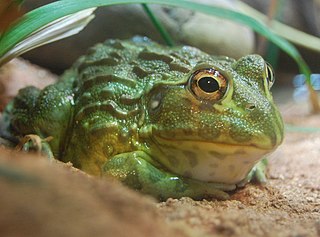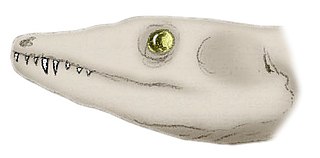
Lepospondyli is a diverse taxon of early tetrapods. With the exception of one late-surviving lepospondyl from the Late Permian of Morocco, lepospondyls lived from the Early Carboniferous (Mississippian) to the Early Permian and were geographically restricted to what is now Europe and North America. Five major groups of lepospondyls are known: Adelospondyli; Aïstopoda; Lysorophia; Microsauria; and Nectridea. Lepospondyls have a diverse range of body forms and include species with newt-like, eel- or snake-like, and lizard-like forms. Various species were aquatic, semiaquatic, or terrestrial. None were large, and they are assumed to have lived in specialized ecological niches not taken by the more numerous temnospondyl amphibians that coexisted with them in the Paleozoic. Lepospondyli was named in 1888 by Karl Alfred von Zittel, who coined the name to include some tetrapods from the Paleozoic that shared some specific characteristics in the notochord and teeth. Lepospondyls have sometimes been considered to be either related or ancestral to modern amphibians or to Amniota. It has been suggested that the grouping is polyphyletic, with aïstopods being primitive stem-tetrapods, while recumbirostran microsaurs are primitive reptiles.

Sphenacodontidae is an extinct family of sphenacodontoid synapsids. Small to large, advanced, carnivorous, Late Pennsylvanian to middle Permian "pelycosaurs". The most recent one, Dimetrodon angelensis, is from the latest Kungurian or, more likely, early Roadian San Angelo Formation. However, given the notorious incompleteness of the fossil record, a recent study concluded that the Sphenacodontidae may have become extinct as recently as the early Capitanian. Primitive forms were generally small, but during the later part of the early Permian these animals grew progressively larger, to become the top predators of terrestrial environments. Sphenacodontid fossils are so far known only from North America and Europe.

Haptodus is an extinct genus of basal sphenacodont, member of the clade that includes therapsids and hence, mammals. It was at least 1.5 metres (5 ft) in length. It lived in present-day France during the Early Permian. It was a medium-sized predator, feeding on insects and small vertebrates.
Christopher Howard Conlin is a former professional American football player and an All-American offensive tackle at Penn State University.

Pholiderpeton is an extinct genus of embolomere amphibian which lived in the Late Carboniferous period (Bashkirian) of England. The genus was first named by Thomas Henry Huxley in 1869 to include the species P. scutigerum, based on the disarticulated front half of a skeleton discovered near Bradford, Yorkshire. Associated fossil wood suggests that this specimen died inside a Lepidodendron tree trunk.

Macroleter is an extinct genus of nycteroleterid parareptile which existed in Oklahoma and Russia during the upper Permian period. It was a quite generalized primitive reptile, in many ways resembling their amphibian ancestors. It was first named by paleontologists Tverdochlebova and Ivachnenko in 1984. According to classification by Michel Laurin and Robert R. Reisz, the genus is a parareptile, belonging to the same branch as Millerettidae, Procolophonidae and other generalized anapsid reptiles. The type species is Macroleter poezicus from Upper Permian of Russia.

Gephyrostegus is a genus of extinct gephyrostegid reptiliomorph amphibian. It was a small animal at 22 cm snout-vent length, of generally lizard-like build and presumably habit. It had large eyes and a large number of small, pointed teeth, indicating it was an active insectivorous hunter. The remains have been found in Nýřany, Czech Republic, dating from around 310 million years ago.

Pantelosaurus is an extinct genus of basal sphenacodonts known from the Early Permian period of Saxony, Germany. It contains a single species, Pantelosaurus saxonicus.

Palaeohatteria is an extinct genus of basal sphenacodonts known from the Early Permian period of Saxony, Germany. It contains a single species, Palaeohatteria longicaudata.

Iberospondylus is an extinct genus of basal temnospondyl amphibian which lived in a marine environment. The type material was found in the Emma Quarry Amphibian Bed of the Puertollano Basin, Ciudad Real province, southern Spain and extended the record for temnospondyls on the peninsula by 45 million years. Along with the holotype, a skull with several disarticulated vertebrae and ribs, two other partial skeletons are known. The name is derived from "Iberia" name of the peninsula where Spain is located, plus "spodylos", Greek for vertebra. The species name is in honor of Dr. Hans-Peter Schultze.

The Pyxicephalidae are a family of frogs currently found in sub-Saharan Africa. However, in the Eocene, the taxon Thaumastosaurus lived in Europe.

Owenetta is an extinct genus of owenettid procolophonian parareptile. Fossils have been found from the Beaufort Group in the Karoo Basin of South Africa. Although most procolophonians lived during the Triassic, Owenetta existed during the Wuchiapingian and Changhsingian stages of the Late Permian as well as the early Induan stage of the Early Triassic. It is the type genus of the family Owenettidae, and can be distinguished from other related taxa in that the posterior portion of the supratemporal bears a lateral notch and that the pineal foramen is surrounded by a depressed parietal surface on the skull table.

Apsisaurus is an extinct genus of Early Permian varanopid synapsids known from Texas of the United States. It was first named by Michel Laurin in 1991 and the type species is Apsisaurus witteri. Apsisaurus witteri is known from the holotype MCZ 1474, a three-dimensionally preserved partial skeleton including an incomplete skull and mandibles. The skull roof of Archeria is also articulated to the postcranial skeleton. It was collected in the Archer City Bonebed 1 site, from the Archer City Formation of the Wichita Group, dating to the Early Permian epoch. Apsisaurus was formerly assigned as an "eosuchian" diapsid. In 2010, it was redescribed by Robert R. Reisz, Michel Laurin and David Marjanović; their phylogenetic analysis found it to be a basal varanopid synapsid.

Cutleria is an extinct genus of basal sphenacodontids or derived stem-sphenacodontoid known from the Early Permian period of the Colorado, United States. It contains a single species, Cutleria wilmarthi.
Fallax is a genus of brachiopods belonging to the family Aulacothyropsidae.
Tichosina is a genus of brachiopods belonging to the family Terebratulidae.
Kanakythyris is a monotypic genus of brachiopods belonging to the family Terebratulidae. The only species is Kanakythyris pachyrhynchos.
Dallithyris is a genus of brachiopods belonging to the family Terebratulidae.












